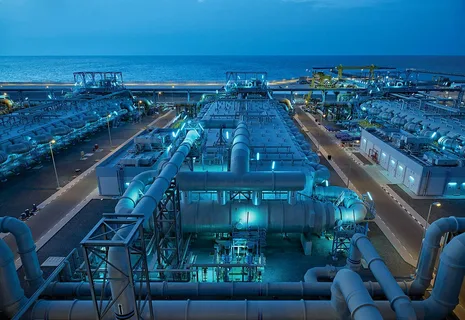| Introduction The Water Desalination Market focuses on technologies and processes that remove salts and impurities from seawater, brackish water, or wastewater to produce potable water. With global water scarcity, urbanization, and industrial growth, desalination has become a critical solution to meet freshwater demand. Desalination plants are deployed worldwide, utilizing technologies such as reverse osmosis (RO), multi-stage flash (MSF), and multi-effect distillation (MED). Increasing investment in sustainable water solutions, government support, and rising awareness about water conservation are driving market growth globally. Market Drivers Key drivers include escalating freshwater demand, population growth, and industrialization. Regions facing severe water scarcity, such as the Middle East, Africa, and parts of Asia, are investing heavily in desalination projects. Technological advancements in RO membranes, energy recovery systems, and low-energy desalination processes enhance efficiency and reduce operational costs. Government initiatives promoting water security and sustainability, combined with private sector investment in desalination infrastructure, further support market expansion. Additionally, industries such as power generation, oil & gas, and manufacturing are increasingly adopting desalinated water to meet operational requirements. Market Challenges Challenges include high capital and operational costs, energy-intensive processes, and environmental concerns related to brine disposal. Maintenance and scaling of desalination equipment require expertise and add to long-term expenses. Regulatory restrictions and environmental compliance issues can delay projects. Dependence on energy-intensive processes increases operational costs, especially in regions with high electricity prices. Moreover, competition from alternative water sources, such as rainwater harvesting and water recycling, may limit market growth in certain regions. Opportunities Opportunities lie in renewable energy-powered desalination, modular plant development, and emerging markets with water scarcity challenges. Integration with solar or wind energy can reduce costs and environmental impact. Innovations in membrane technology and smart monitoring systems enhance efficiency and reliability. Developing countries with limited freshwater access provide potential for infrastructure expansion. Industrial adoption and municipal water projects also create opportunities for long-term market growth. Regional Insights The Middle East leads desalination capacity, driven by countries like Saudi Arabia, UAE, and Kuwait, which rely heavily on desalinated water. Asia-Pacific, particularly India, China, and Australia, is witnessing growing adoption due to population pressures and industrial water demand. North America and Europe focus on advanced, energy-efficient desalination solutions and wastewater reuse integration. Africa presents emerging opportunities with expanding infrastructure to address water scarcity challenges. Latin America is gradually investing in desalination projects for urban and industrial use. Future Outlook By 2032, the Water Desalination Market is expected to expand significantly, driven by technological innovations, renewable energy integration, and global water scarcity concerns. Adoption of low-energy desalination technologies, smart monitoring, and digital solutions will enhance operational efficiency. Public-private partnerships and government incentives will further accelerate market growth. Desalination will play a vital role in ensuring water security for residential, industrial, and municipal applications worldwide. Conclusion The Water Desalination Market is a crucial solution to global freshwater scarcity. While high costs and energy requirements remain challenges, technological advancements, renewable energy integration, and supportive government policies are driving market growth. Desalination will continue to provide sustainable, reliable water solutions globally. |
